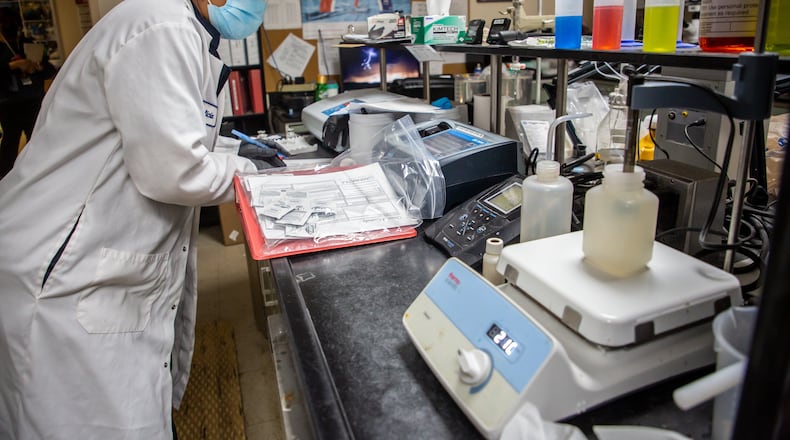Everyone poops — including people with COVID-19.
Since the onset of the pandemic, scientists have analyzed wastewater to measure the amount of coronavirus-laced genetic material shed from infected residents. They’re able to use that data to identify potential outbreaks, often days before residents begin to feel sick and get tested.
The Centers for Disease Control and Prevention announced last month a nationwide effort to gather and test more wastewater samples. Georgia health officials told The Atlanta Journal-Constitution they’re ramping up sewage sampling across the state and recruiting water treatment plants to participate. With more than 900 sewage treatment facilities scattered across Georgia, scientists said this data could become a new barometer for public officials and residents to figure out how their communities are faring with COVID-19, especially since testing is becoming less reliable.
“This could become something like a weather report or a pollen count. If the pollen is high, you might not want to spend a lot of time outdoors,” said Christine Moe, the director of the Center for Global Safe Water, Sanitation, and Hygiene at Emory University. “If you see that the virus levels are going up in the wastewater, you may be more careful and make decisions about what you will and will not do.”
The CDC added wastewater data to its public coronavirus data tracker on Feb. 4. Hundreds of sites in the U.S. are already participating in the CDC’s sewage analysis program, testing their water multiple times each week. But only two places in Georgia — DeKalb County and Augusta — are currently providing wastewater samples.
The Georgia Department of Public Health said more will soon join them.
Amanda Feldpausch, an epidemiologist over the state’s wastewater testing efforts, said they’re working with several treatment plants across Georgia to collect data and pass it along to the CDC over the next few months. She said they aim to build a statewide network where sewage can be analyzed for coronavirus variants and eventually other pathogens that may emerge.
“Our ultimate goal is to be able to use this as a low-cost and robust surveillance system,” Feldpausch said.”
Tracking and eradicating viruses
Scientists have been tracking viruses through sewers for decades.
While polio has been eradicated in the U.S. since the late 1970s, health officials in several countries rely on wastewater sampling to track lingering cases. There have been plenty of individual wastewater studies in the U.S., but the CDC’s current effort to track coronavirus is ramping up to an unprecedented scale.
“The beauty of taking sewage samples is that you can pick up virus (materials) that’s excreted by cases that have been diagnosed, cases that were not diagnosed, cases where people had symptoms and cases where people might not even realize they’ve been infected because they don’t have symptoms,” Moe said.
Emory, Georgia Tech and the University of Georgia have conducted and are continuing some of their own COVID-19 tracking studies using wastewater. Erin Lipp, a professor of environmental health science at UGA, has maintained a database tracking trends from Athens-Clarke County’s wastewater since June 2020. Her data consistently provides an early warning of rising infections days before lab test results begin to rise.
“It’s proven to be a pretty valuable tool.” Lipp said. “We have really nice correlations with reported case rates of COVID-19. Our lead time varies, but on average our increases lead case counts by about three to five days.”
She said it’s important to invest in sewage data analysis, because the number of people seeking lab tests and reporting their positive results has begun to drop. Home tests are not tracked, so only the results from tests offered in medical offices or mass testing sites are recorded. Several mass testing sites around Georgia have closed following the drop in omicron cases.
“Especially when testing rates go down, everybody’s sort of worried that they don’t really know what’s going on in terms of the pandemic within Athens-Clarke County,” Lipp said. “The wastewater information gives you a little bit of a less biased view of that, because it doesn’t require people to be seeking tests.”
A new monitoring method
Health officials say monitoring sewers can provide a supplementary source of information on outbreaks as test results dwindle. The wastewater data could help local leaders decided where to send mobile testing sites, increase vaccine outreach or boost hospital resources.
Georgia health officials said they haven’t received much pushback or skepticism from water treatment plants. Last week, Politico reported some states, such as North Dakota and Wyoming, have declined to participate with the CDC’s program, citing privacy concerns and logistical challenges.
However, health officials said anonymity is essentially guaranteed, since many water treatment plants process millions of gallons of sewage each day and serve hundreds of thousands of people.
“Because it’s a sample from a population, there’s less concern about privacy. You don’t know who is infected,” Moe said.
Public sewers also serve the majority of Americans, especially in urban areas.
Federal estimates show roughly 80% of the country is connected to public sewer systems, while Georgia’s connectivity is estimated to be about 62%, according to the Georgia Department of Natural Resources. Everyone else relies on private septic systems, which usually aren’t analyzed for viral genetic material.
More than 95% of residents in some rural counties, such as Baker and Webster counties in southwest Georgia, use septic systems. In the five-county metro Atlanta area, between 6% and 21% of residents use septic systems.
“For areas that this sort of trend data would be really helpful, we have really good coverage with public water,” Feldpausch said.
Plastic jugs and sewage streams
Water treatment plants already collect samples every day to measure everything from pH levels to ammonia concentrations.
While it isn’t a glamorous gig, Kenneth Gobin, the plant manager of Snapwater Creek Treatment Plant in south DeKalb, said it’s a quick and easy process. Collecting one more sample to send to the CDC was an easy decision.
“All it is is grabbing (the sample) and boxing it up,” Gobin said.
Credit: Steve Schaefer
Credit: Steve Schaefer
On Friday morning , he used a rope to dip a plastic jug into the county’s sewage stream, which ran directly from nearby neighborhoods into the facility. Within a minute, he had a six-ounce sample ready to be shipped to the CDC’s third-party testing lab, LuminUltra. FedEx would pick up the sample around lunchtime, he said.
The CDC program is free for participants. Allen Saxon, assistant director of facilities operations in Augusta, said it was a no-brainer to provide samples.
“I don’t know why they wouldn’t (participate),” Saxon said. “There’s not much to it, and it doesn’t cost you anything except maybe a half-hour’s time of somebody.”
While health officials said wastewater data is useful for residents to keep in mind, they said the data can be easily blown out of proportion. The CDC’s data tracker lists results as a percent change over a 15-day period, meaning small changes or outliers could result in a seemingly large change, even if the actual increase or decrease in coronavirus materials is small.
“There’s a lot of sites across the country that are showing increases, but when you’re going from zero or really low levels to some higher level, the percent increase can look really high even if it’s just a little blip,” Lipp said.
Richmond County, where Augusta is located, had a one-day spike in mid-February where the percent change increased by more than 5,000%. However, health experts were unable to explain the spike, which only lasted a few days. The percent change is more useful in documenting long-term trends, rather than a measure of how many people are infected.
Georgia health officials said they’ve recruited several pilot plants. Feldpausch wouldn’t say how many plants agreed to participate, but members of the Cobb County Water System and Gwinnett County Department of Water Resources told the AJC they’re helping provide samples. The Atlanta Department of Watershed Management is also “in discussions” with Feldpausch’s team, according to a statement.
“We’re really looking to grow this program sustainably,” Feldpausch said.
Lipp also said she intends to provide UGA’s sewer data to the state and CDC as counties and organizations begin to consolidate their efforts.
“If you’re really trying to understand how predictive a wastewater signal can be, the more data points you have, the better,” she said.
About the Author
The Latest
Featured



